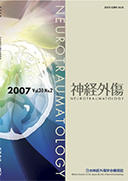30 巻, 1 号
神経外傷
選択された号の論文の9件中1~9を表示しています
- |<
- <
- 1
- >
- >|
原著:頭部外傷データバンク
-
原稿種別: 研究論文
2007 年 30 巻 1 号 p. 1-6
発行日: 2007/12/27
公開日: 2022/06/27
PDF形式でダウンロード (1447K)
原著:「頭部外傷に伴う低髄液圧症候群」作業部会報告
-
原稿種別: 研究論文
2007 年 30 巻 1 号 p. 7-13
発行日: 2007/12/27
公開日: 2022/06/27
PDF形式でダウンロード (1233K) -
原稿種別: 研究論文
2007 年 30 巻 1 号 p. 14-20
発行日: 2007/12/27
公開日: 2022/06/27
PDF形式でダウンロード (2213K) -
原稿種別: 研究論文
2007 年 30 巻 1 号 p. 21-29
発行日: 2007/12/27
公開日: 2022/06/27
PDF形式でダウンロード (1549K) -
原稿種別: 研究論文
2007 年 30 巻 1 号 p. 30-37
発行日: 2007/12/27
公開日: 2022/06/27
PDF形式でダウンロード (2821K)
原著
-
原稿種別: 研究論文
2007 年 30 巻 1 号 p. 39-44
発行日: 2007/12/27
公開日: 2022/06/27
PDF形式でダウンロード (1571K) -
原稿種別: 研究論文
2007 年 30 巻 1 号 p. 45-52
発行日: 2007/12/27
公開日: 2022/06/27
PDF形式でダウンロード (1136K) -
原稿種別: 研究論文
2007 年 30 巻 1 号 p. 53-60
発行日: 2007/12/27
公開日: 2022/06/27
PDF形式でダウンロード (2108K)
症例報告
-
原稿種別: 症例報告
2007 年 30 巻 1 号 p. 61-66
発行日: 2007/12/27
公開日: 2022/06/27
PDF形式でダウンロード (1542K)
- |<
- <
- 1
- >
- >|
